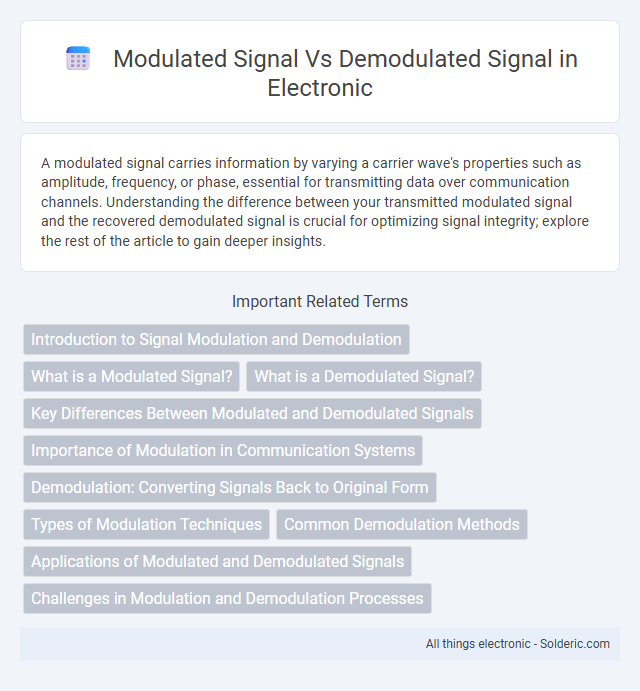A modulated signal carries information by varying a carrier wave's properties such as amplitude, frequency, or phase, essential for transmitting data over communication channels. Understanding the difference between your transmitted modulated signal and the recovered demodulated signal is crucial for optimizing signal integrity; explore the rest of the article to gain deeper insights.
Comparison Table
| Feature | Modulated Signal | Demodulated Signal |
|---|---|---|
| Definition | Signal with information encoded onto a carrier wave | Original baseband signal extracted from the modulated carrier |
| Purpose | Transmit data over long distances or through mediums | Recover transmitted data for processing or output |
| Frequency | High frequency, shifted to carrier frequency | Low frequency, represents original data bandwidth |
| Components | Carrier wave + encoded information (amplitude, frequency, or phase variations) | Decoded amplitude, frequency, or phase variations representing original data |
| Signal Type | Composite, often complex waveform | Simple baseband waveform |
| Usage | Wireless communication, broadcasting, data transmission | Signal processing, data retrieval, audio/video playback |
Introduction to Signal Modulation and Demodulation
Signal modulation involves varying a carrier wave's properties such as amplitude, frequency, or phase to encode information for transmission. Demodulation is the reverse process where the receiver extracts the original information from the modulated carrier wave. Modulated signals enable efficient and reliable communication over various media, while demodulated signals restore the transmitted data for further processing.
What is a Modulated Signal?
A modulated signal is a carrier wave that has been altered by varying its amplitude, frequency, or phase to encode information for transmission. This signal enables efficient data transfer over long distances by adapting to different transmission environments and reducing interference. Your communication system relies on the modulated signal to carry the original message before it is recovered in the demodulation process.
What is a Demodulated Signal?
A demodulated signal is the original information extracted from a modulated carrier wave during the demodulation process, reversing the modulation used for transmission. This signal restores the data's original form, such as audio, video, or digital information, enabling effective communication and accurate data recovery. Your devices rely on demodulated signals to interpret and use the transmitted information correctly.
Key Differences Between Modulated and Demodulated Signals
Modulated signals carry information by varying a carrier wave's amplitude, frequency, or phase, facilitating efficient transmission over distances. Demodulated signals are extracted versions of the original data, recovered by reversing the modulation process at the receiver end. Key differences include modulation embedding information within carrier waves, whereas demodulation retrieves this embedded data, enabling interpretation and processing.
Importance of Modulation in Communication Systems
Modulation in communication systems enables the efficient transmission of signals over long distances by converting baseband information into modulated signals suitable for propagation through various media. Modulated signals facilitate multiplexing, allowing multiple signals to share a single communication channel, which enhances bandwidth utilization and reduces interference. The demodulated signal recovers the original information at the receiver end, ensuring accurate data reconstruction and effective communication.
Demodulation: Converting Signals Back to Original Form
Demodulation is the process of converting modulated signals, which carry information by varying carrier wave properties, back into their original baseband form for interpretation and processing. During demodulation, techniques such as amplitude, frequency, or phase demodulation extract the embedded information by reversing modulation effects, enabling accurate recovery of data. Efficient demodulation is essential in communication systems, ensuring signal integrity and minimizing information loss during transmission over channels.
Types of Modulation Techniques
Modulated signals use various techniques such as Amplitude Modulation (AM), Frequency Modulation (FM), and Phase Modulation (PM) to encode information onto a carrier wave for efficient transmission. Demodulated signals extract the original information from the modulated carrier by reversing these processes using corresponding demodulation methods like AM demodulation, FM demodulation, or Phase detection. Your choice of modulation technique impacts signal quality, bandwidth efficiency, and resistance to noise, crucial for optimizing communication systems.
Common Demodulation Methods
Modulated signals carry information by varying a carrier wave's amplitude, frequency, or phase, while demodulated signals represent the extracted original information after processing. Common demodulation methods include Amplitude Demodulation for AM signals, Frequency Demodulation for FM signals, and Phase Demodulation for PM signals, each designed to reverse the specific modulation technique used. Coherent demodulation requires a synchronized carrier reference, while envelope detection offers a simpler, non-coherent approach suitable for many amplitude-modulated signals.
Applications of Modulated and Demodulated Signals
Modulated signals are crucial in wireless communication systems, enabling efficient transmission of data across long distances by varying carrier wave properties such as amplitude, frequency, or phase. Demodulated signals allow your receiver devices to extract and convert these variations back into the original information, essential for applications like radio broadcasting, satellite communication, and digital television. Both modulated and demodulated signals play vital roles in radar systems, mobile networks, and data transmission, ensuring reliable and clear communication.
Challenges in Modulation and Demodulation Processes
Challenges in the modulation process include maintaining signal integrity while efficiently encoding information onto a carrier wave, often complicated by noise and interference that can distort the modulated signal. Demodulation faces difficulties in accurately extracting the original information from the received modulated signal, requiring precise synchronization and filtering techniques to minimize errors caused by channel impairments. Both processes demand robust algorithms to handle variations in signal strength, multipath fading, and bandwidth constraints to ensure reliable communication.
Modulated signal vs demodulated signal Infographic

 solderic.com
solderic.com